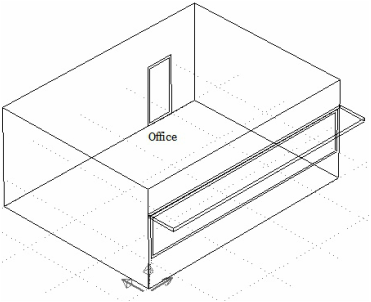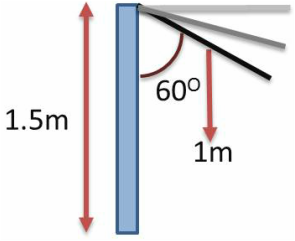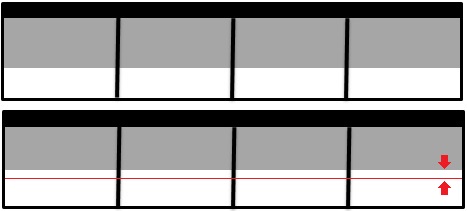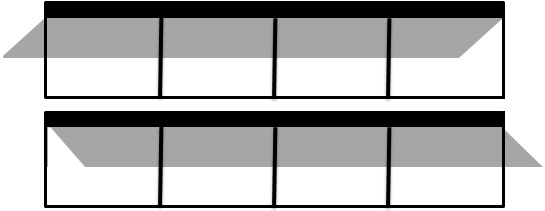Shading Model Methodology
As previously mentioned, shading is a common addition to façades and there are many different variations of shading devices being used in and on buildings today. These include louvers, overhangs and blinds. Within the scope of our project we decided to focus on overhangs and if they could be used dynamically on the façade . We modeled these overhangs on ESP-r for two different cases. In the first case we experimented with a variable depth of the overhang and in the second case with a variable tilt of overhang. It was necessary to do a weekly analysis and define the position of the shading devices manually every week because ESP-r doesn't support dynamic shading simulation.
|
For the case of varying depth, the overhang had a shade above the window which was 8 meters long, the full length of the room. The depth was varied between 0.1 meters and 1 meters for each simulation and this depth was determined by the sun-path analysis. The sun path analysis determined the suns altitude at noon and then we used this to determine what depth the shade should be for that week to provide the maximum shade coverage for the window. The sun path analysis showed that the minimum depth was needed in summer when the sun's altitude was 89° and the maximum depth needed in winter when the suns altitude was only 42°. |
|
Similarly, we ran simulations for the case of varying angle of the shade. Again, the shade was kept at 8 meters long, the full length of the room. The angle of the shade was then varied for each week of simulation between 90° (maximum tilt) and 60°(minimum tilt). As with the case of dynamic tilt, the angle of tilt was determined via the sun path analysis with the suns altitude at noon used to define which angle the shade should be at. The maximum angle of 90° was needed during the summer and the minimum angle of 60° needed during winter. Simulations were run weekly for this model.
|
|
ESP-r gives the option to include solar obstructions for the building simulations. However, it doesn’t support the tilt modification of the solar obstruction. For this reason, two sun obstructions were created to represent tilt, hypotenuse was kept constant at 1m and the two vertical sides were altered to define the angle of the shading device as shown in the picture opposite.
|
Simulations were also run for a model with a static over hang and static tilt. i.e. The shade was kept in the same position. This was done in order to allow a comparison between dynamic shading devices and standard passive devices to be made when we came to analyse the results from the simulations.
From the sun path analysis, we found that the sun’s altitude at noon when the need for shading is most important, doesn’t change significantly throughout the week. This means that the depth or tilt of the dynamic shading device doesn’t need to be changed every single day.
From the sun path analysis, we found that the sun’s altitude at noon when the need for shading is most important, doesn’t change significantly throughout the week. This means that the depth or tilt of the dynamic shading device doesn’t need to be changed every single day.
Also there is no need to change the depth or tilt throughout the day because the maximum depth/tilt can be applied for the sun’s altitude at noon when the temperature is higher. In the morning and in the afternoon, even though the window coverage by shading is slightly smaller, the temperatures are lower.
Simulation procedure
1. Find sun’s maximum altitude for every week throughout the year (usually around 12:00 noon).
2. Define the position of the shading device according to the sun’s position during noon when the sun’s altitude takes its highest value (usually around 12:00) so that the shading device provides maximum coverage with shading on the window. The goal is to provide 100% shading but if the shading device has specific dimensions then define appropriate tilt/depth so that it covers the window with shading as much as possible. This process needs to be repeated for every week throughout the year (52 weeks).
3. Run the simulation for each week separately, changing the position of the shading device each time according to the sun path analysis.
4. Record the results of the weekly simulations including the energy used for heating and cooling inside the office.
5. The sum of energy used for heating/cooling inside the office of the 52 weeks gives the annual energy used inside the building.
Evaluation procedure
Evaluation of a dynamic shading device by comparing the energy used inside the office before and after the application of the device on the façade.
Evaluation of a dynamic shading device by comparing the energy used inside the office when the shading device is dynamic and when the shading device has a fixed optimum position.
1. Find the annual energy for heating/cooling inside the office which has no shading devices on its façade (base case model).
2. Find the annual energy for heating/cooling inside the office after applying the dynamic shading device on its façade.
3. Find the annual energy for heating/cooling inside the office while keeping the shading device fixed in the optimum position on the façade throughout the whole year.
4. Compare the results.
Notes
1. The two shading devices which were investigated (tilt, depth) required no change in their position throughout the day or throughout the week because they wouldn’t provide significant improvements in the energy used for heating/cooling inside the building. If alternative shading devices were to be evaluated and required a change of position throughout the day, then the previous methodology is not applicable. It should also be noted that ESP-r cannot run simulations for less than 24 hours.
2. It is important to find the annual energy used inside the office instead of comparing the energy reduction during winter and/or summer (extreme conditions) because the reduction in the energy used during one of the seasons is not representative of energy requirements for the whole year and may lead to false conclusions.
3. In this evaluation, there was no use of lighting control inside the office and there was a steady lighting schedule for the whole year. Normally, when the daylight inside the office is sufficient people would turn the lights off by themselves. This could potentially save energy in two ways. Firstly, by reducing the energy used by the lights (and the energy bill) as they would operate less hours. Secondly, as light can increase temperature inside a building, have them switched off would reduce energy consumption further. For this reason, in order to achieve a more accurate evaluation it is essential to include a sensor inside the office that would detect the solar irradiance levels and arrange the operation of lights accordingly.
1. Find sun’s maximum altitude for every week throughout the year (usually around 12:00 noon).
2. Define the position of the shading device according to the sun’s position during noon when the sun’s altitude takes its highest value (usually around 12:00) so that the shading device provides maximum coverage with shading on the window. The goal is to provide 100% shading but if the shading device has specific dimensions then define appropriate tilt/depth so that it covers the window with shading as much as possible. This process needs to be repeated for every week throughout the year (52 weeks).
3. Run the simulation for each week separately, changing the position of the shading device each time according to the sun path analysis.
4. Record the results of the weekly simulations including the energy used for heating and cooling inside the office.
5. The sum of energy used for heating/cooling inside the office of the 52 weeks gives the annual energy used inside the building.
Evaluation procedure
Evaluation of a dynamic shading device by comparing the energy used inside the office before and after the application of the device on the façade.
Evaluation of a dynamic shading device by comparing the energy used inside the office when the shading device is dynamic and when the shading device has a fixed optimum position.
1. Find the annual energy for heating/cooling inside the office which has no shading devices on its façade (base case model).
2. Find the annual energy for heating/cooling inside the office after applying the dynamic shading device on its façade.
3. Find the annual energy for heating/cooling inside the office while keeping the shading device fixed in the optimum position on the façade throughout the whole year.
4. Compare the results.
Notes
1. The two shading devices which were investigated (tilt, depth) required no change in their position throughout the day or throughout the week because they wouldn’t provide significant improvements in the energy used for heating/cooling inside the building. If alternative shading devices were to be evaluated and required a change of position throughout the day, then the previous methodology is not applicable. It should also be noted that ESP-r cannot run simulations for less than 24 hours.
2. It is important to find the annual energy used inside the office instead of comparing the energy reduction during winter and/or summer (extreme conditions) because the reduction in the energy used during one of the seasons is not representative of energy requirements for the whole year and may lead to false conclusions.
3. In this evaluation, there was no use of lighting control inside the office and there was a steady lighting schedule for the whole year. Normally, when the daylight inside the office is sufficient people would turn the lights off by themselves. This could potentially save energy in two ways. Firstly, by reducing the energy used by the lights (and the energy bill) as they would operate less hours. Secondly, as light can increase temperature inside a building, have them switched off would reduce energy consumption further. For this reason, in order to achieve a more accurate evaluation it is essential to include a sensor inside the office that would detect the solar irradiance levels and arrange the operation of lights accordingly.
_





